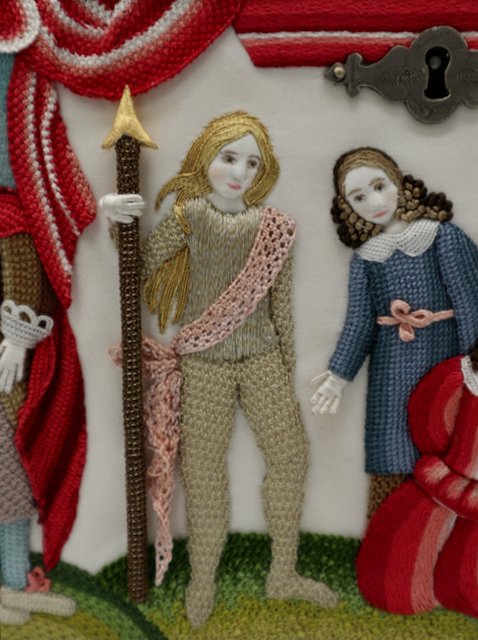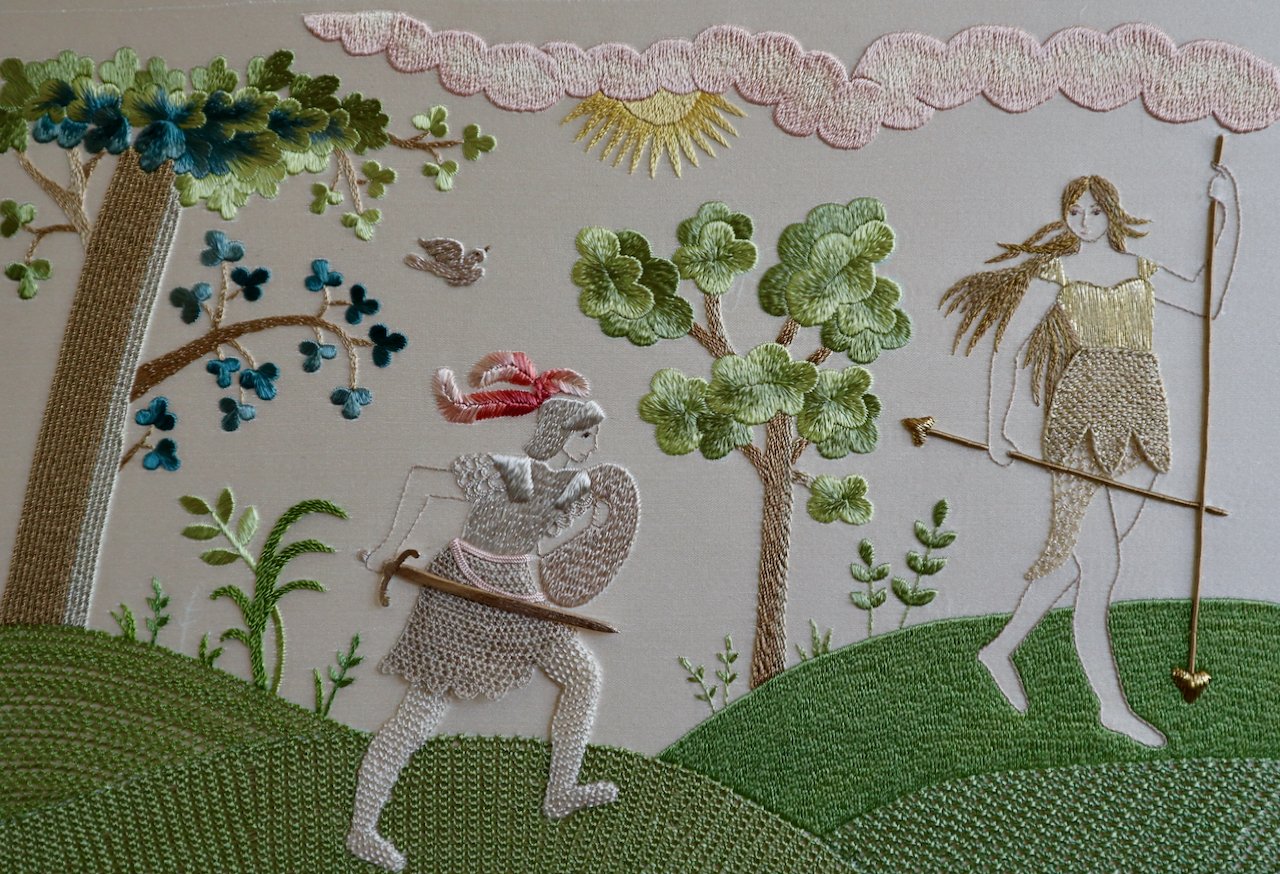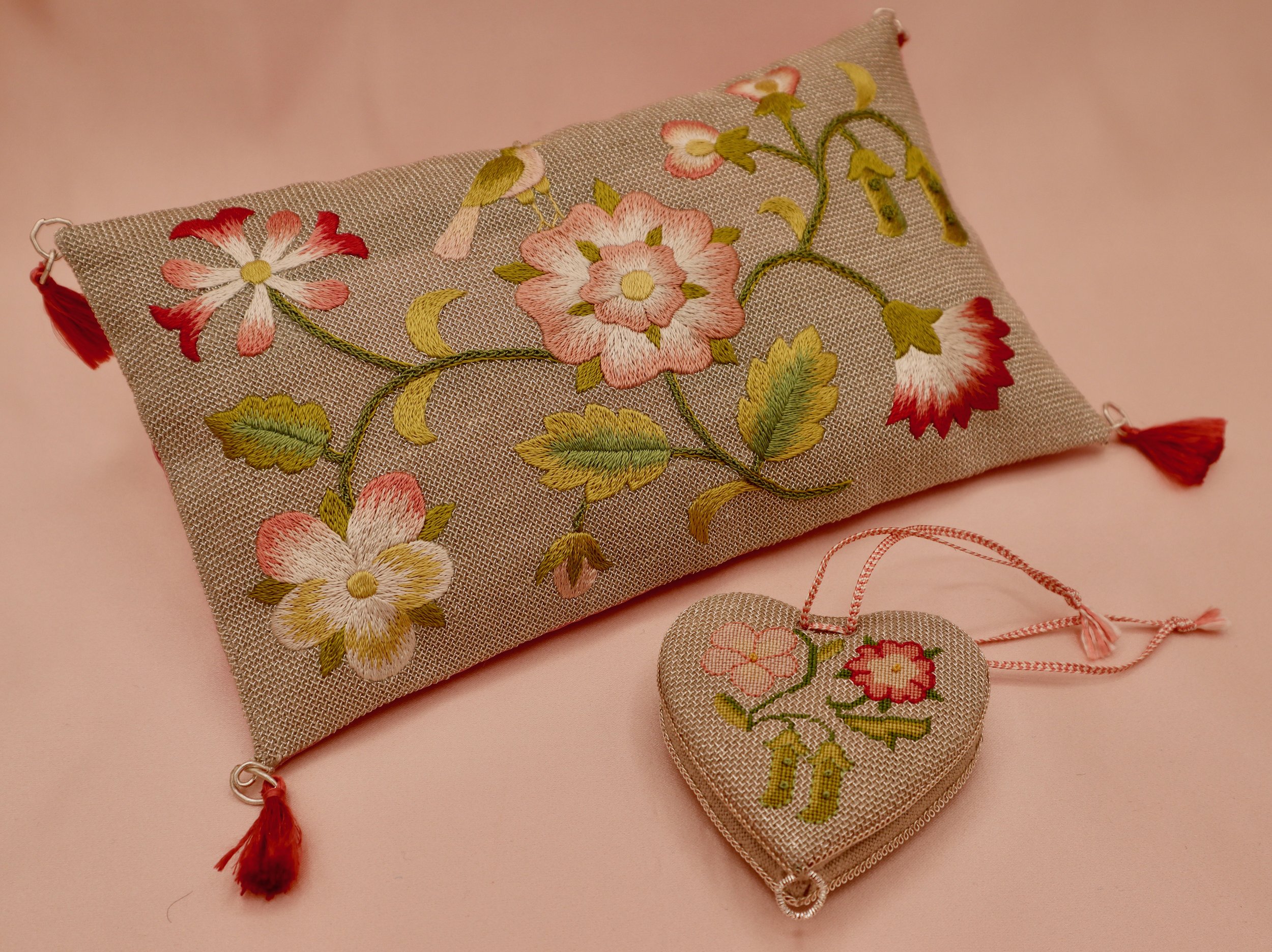The Britomart Suite
The Britomart suite is a modern interpretation of a full 17th century schoolgirl needlework education, comprising a stumpwork casket, reversible polychrome band sampler, and two exquisite complementary smalls. The accompanying objects were all designed to be stored inside the casket.
The 17th century needlework suite is typified by the surviving suites of Martha Edlin, Hannah Downes, and Elizabeth Hall (as explored in the Witney Antiques exhibition and catalogue Choice and Precious Work), showing us the full range of the 17th century schoolgirl needlework education.
The story of Britomart
The Britomart casket takes its name from the story it depicts, of Edmund Spenser’s female knight from his epic poem The Faerie Queene. Written late in the Elizabethan age to curry favor with a female ruler, book 3 of The Faerie Queene tells the story of Britomart. Britomart, a princess of Britain, sees her destiny in a magic mirror (depicted on the left side of the casket), and travels to Faerie Lond to seek him, assuming the guise of a male knight. Britomart disguises herself as the Knight of the Ebony Spear - as depicted in the closeup above from the front of the casket, she carries a magical ebony lance that cannot be defeated - and quests across Faerie Lond, seeking her destiny and true love, Artegall.
The casket depicts Britiomart’s journey from princess of Britain to female knight triumphant, showing her journey from relying on the disguise of masculinity, to her reveal as a female knight - the moment depicted in the image above, victorious after a tournament.
According to the mythology of the poem, Britomart and Artegall are destined to marry and beget a great line of kings, founding a dynasty that will eventually produce Queen Elizabeth I of England. The house of Tudor claimed descent from King Arthur to bolster their legitimacy so Spenser, seeking Elizabeth’s favor, littered his epic with references to Arthurian mythology. Arthur himself is a character in the poem, as a young knight who has not yet become the king of legend, and in love with the Faerie Queene (an allegorical representation of Elizabeth). But as Spenser could do nothing by halves, Britomart’s love Artegall is also a figure meant to invoke the Arthur of legend, so by the peculiar logic of the poem the contemporary Queen Elizabeth I was both the ideal bride for King Arthur, and descended from him.
A full explanation of the story as depicted on each side of the casket can be found here
The casket
The casket is worked in a variety of techniques but relies heavily on high relief stumpwork. Inspired by many of my favorite 17th century pieces, it is a homage to spectacular historic pieces and my own love of literature.
One of the visual themes is of looking and perception - Britomart looking in the magic mirror as the moment that set the story in motion, and how Britomart is looked at and perceived. The right panel, seen in the image above, depicts the conflict ensuing from mistaken perception, when an amorous hostess seeks an assignation with the guest she thinks is a handsome young man, while the front panel shows Britomart being looked at and perceived by others as her true self, the victorious female knight. Following this, the scene on the lid - of the decisive battle between Britomart and Radigund, her most dangerous foe - is actually of the moment before the battle, where the two combatants look at each other in assessment and preparation.
The scenes depicted on each side of the casket are explained in detail in my flosstube revealing the casket finish, and a full progression of the working of the casket with step by step shots of the embroidery is also on my YouTube channel
The Britomart sampler
The polychrome band sampler usually began a 17th century English schoolgirl needlework education. Generally stitched reversibly with varying degrees of precision, the band sampler was an essential learning piece that laid the foundation for a girl to continue to more ambitious projects like a casket. The lessons of the band sampler taught the girl skills that she would need in her later projects.
The Britomart sampler, designed as a companion piece to the Britomart casket, is a reversible band sampler inspired by a variety of 17th century band samplers, reworked in a cohesive, streamlined colorway - meant to pair the best of 17th century inspiration with the design and color skill of a modern professional. It covers a full range of techniques, from the basic reversible cross and double running stitch to Montenegrin stitch and needlelace.
Finished with Spenser’s invocation to ‘be bold, be bold, be not too bold’, the Britomart sampler is both a fabulous, aspirational piece of needlework, and a reminder to attempt the same boldness in stitching that was displayed by 17th century schoolgirls. Showing a child’s creativity, imagination, and fearlessness, young girls created some of the most amazing embroidery that has ever been worked.
Available as a chart, kit, and class, the Britomart sampler will take you on the same learning journey as a 17th century girl, allowing you to get into their mindset while learning, and teach you the language of band samplers.
The casket toys
Completed band samplers were generally rolled up and stored inside their accompanying caskets (or a workbox/sewing box if the girl did not attempt a casket), but they were often not the only thing kept inside a casket. Full of hidden spaces and tiny treasures, many caskets originally contained small needlework creations, sometimes called casket toys, created as accessories for their boxes.
Casket toys could be handmade or purchased - the contents of Martha Edlin’s casket included a toy silver tea set as well as items she made herself, ranging from needlework accessories like pincushions, to items that can only be called toys - tiny animals fashioned from gilt and silk thread, and miniature gloves made of silk braid.
The interior cavity of the Britomart casket is lined with pink silk and mirrors, revealing dancing light when opened. Many 17th century caskets had mirrored elements in the interior, and it seemed especially appropriate for the Britomart casket as the story is set in motion when Britomart looks into a magic mirror.
To accent the reflective quality of the interior, I created two needlework smalls defined by sparkling silver background that mimic the light reflected by the interior mirrors of the casket: Queen Anne’s Pyn Pillow, and the Elizabethan Valentine, also the first two classes offered by Katie Strachan Artisan Embroidery.
Together, the objects of the Britomart suite reflect the personal and professional journey of a modern embroiderer.








